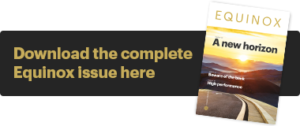Beware of the bank

This article is taken from our spring 2021 edition of Equinox. You can view the full version here.
Since the Bank of England reduced its base rate to 0.1% eleven months ago, many of us have seen the interest rate on our savings fall to eye wateringly low levels. You may have seen that even the generous Marcus has topped the interest rate charts recently by reopening it’s easy access account with a dizzying 0.5% AER.
And with the Bank of England’s Monetary Policy Committee telling banks they should be prepared for negative interest rates over the next six months (although reiterating it shouldn’t signal that this is the intention for the future) it certainly doesn’t bode well for what you can expect on your hard earned cash anytime soon.
It’s not just the low rates of interest that are of concern it’s the very real risk that inflation will erode the real value of your money.
Inflation vs volatility – which is riskier?
As financial planners, we talk a lot about risk with clients and this is often characterised by discussions around volatility – how far up and down the value of your investments go in relation to the market. However, cash, unlike investment portfolios, doesn’t suffer volatility. The only time you’ll see your bank balance decrease is when you spend it.
But for savers, inflation risk is like carbon monoxide. You can’t see it, smell it or feel it but, given enough time, it will slowly chip away and kill your wealth.
As an asset class, cash is never expected to grow your wealth but rather maintain the real value (after inflation) of your money through interest rates. But if the cost of goods and services increases higher than the interest rate you’re receiving, then the amount each £1 saved can buy you is falling daily.
Over the last 10 years, the Bank of England base rate has annualised at just below 0.5% per annum. Meanwhile the Consumer Price Index (a measure of inflation) has increased by 1.8% per annum. Essentially, £100,000 saved in 2011 has now fallen to £87,939 in real terms.
In contrast, the same £100,000 invested into equities, aka the riskiest asset class, has grown by 196% (MSCI World to 10 February 2021). Even after taking inflation into account you have a pot of £247,921 in real terms.
Obviously throughout that 10 years you’d have experienced a lot of “volatility”. But it begs the question, “which is riskier – inflation or volatility?”. We can certainly see which is more expensive.
Looking ahead
So, what lays ahead for interest rates and inflation? First let’s look at interest rates.
There are several ways we can attempt to forecast interest rates. One way is to look at the government bond market. In theory, the yield on a secure government bond such as a gilt should reflect future interest rate expectations. At the time of writing, the 10 year gilt yield sits at 0.46% which would imply a relatively low cash return for the next 10 years.
Another method is to look at what central banks are telling us. With the “forward guidance” from both sides of the Atlantic seeming muted it certainly doesn’t seem likely we’ll be seeing interest rates picking up dramatically over the next decade.
So, what about inflation?
Coronavirus and the numerous lockdowns over the past 12 months have, unsurprisingly, had a huge impact on the UK economy. We’ve been less able to go out and spend our hard earned cash and HSBC economists estimate Brits are sitting on an extra £170bn of savings. But with the vaccination rollout well underway, there is a hope that we’ll start to emerge from our respective homes, return to work and begin to spend, spend, spend. So, why does this matter for inflation?
Well, if the pent up demand of the British public increases faster than the bludgeoned UK firms can keep up with then they will begin to put up prices. What is more, they will need to employ more workers to meet the renewed demand thereby increasing their costs. These costs will ultimately be passed onto consumers by increasing prices.
As a result, a rapid recovery could cause upward pressure on prices leading to a higher inflation rate – at least in the short term. With central banks’ primary weapon against inflation being to increase interest rates, does this mean there is a light at the end of the tunnel for savers also?
Unfortunately not in our view.
Targets & motivation
So, how far does inflation need to increase before the Bank of England needs to act?
Firstly, the Bank of England sets a long-term target for inflation of 2% per annum. As mentioned earlier, inflation over the last 10 years has been running at c.1.8%.
This means, that even if inflation ran above target at 3.2% per annum for the next three years, the Bank of England would still be in line with their long-term target of 2%. Even if we saw a very fast 4.6% bounce over one year, they’d still be on target.
Another factor to consider is the explosion of government borrowing in 2020 (£290bn) to combat the impact of Coronavirus and lockdowns pushing the total national debt to a lofty £2.1trn at the end of December. Without doubt this is a dizzying figure, however, the old adage remains; “it’s the size of the payments not the size of the mortgage that matters”.
With interest rates so low, the government has little issue in making repayments and servicing this debt. What is more, an increase in inflation would actually reduce the size of the debt in real terms.
The Bank of England are now independent from the government in their decision making but it does bring into question where the motivation is for the Bank of England to increase interest rates.
You also can’t discount the possibility for the Bank of England to adopt a dual mandate for monetary policy decisions akin to other Central Banks including the Federal Reserve in the US. The result would mean interest rate decisions could be based on other economic factors such as employment or GDP growth as opposed to just price stability and inflation as it is presently.
An alternative approach
Faced with the prospect of lower interest rates and the potential that short-term inflation will be palatable for the Bank of England, what are savers to do?
In early February, we were pleased to announce the launch of our new Defensive Fund.
The fund aims to outperform cash (Bank of England base rate) by at least 3%* per annum over the long term (five years or more), with less risk than our other portfolios.
It may be suitable for those investing over shorter time periods or those with a lower risk tolerance. Or it can be combined with our other four portfolios as part of a wider horizon plan.
*(This is a target return, not a guarantee. Past performance is not a guide to future performance).
Disclaimer: The content contained in this blog represents represents the opinions of Equilibrium Investment Management LLP (EIM) and Equilibrium Financial Planning LLP (EFP). The commentary in no way constitutes a solicitation of investment advice. It should not be relied upon in making investment decisions and is intended solely for the entertainment of the viewer. Past performance is never a guide to future performance. Investments may (will) fall as well as rise and you may not get back your original investment.’


